Free webinar today, WEEDLESS GARDENING
/0 Comments/in Gardening/by Lee Reich“WEEDLESS GARDENING” webinar
Are you interested in having a weedless garden this season? Yes? Learn how at my upcoming WEEDLESS GARDENING webinar. The system I’ll describe does more that just deal with weeds. It also lets your garden use water more efficiently, conserves valuable soil organic matter, lets you plant earlier in spring, and does not disrupt beneficial fungi and other friendly soil organisms. Starting a new garden? Here’s the fastest way to get the soil prepared and plants growing.
I’ll cover all this, and more, in the WEEDLESS GARDENING webinar. The webinar is free, at 2 pm EST on Sunday, June 6, 2021.
This webinar is sponsored by Inniswood Garden Society. To register for this program, please visit: www.bit.ly/AnnualMtgRegister
GOD’S BEST BERRY?
/16 Comments/in Fruit/by Lee ReichFirst Good-Tasting Berries of the Season
Strawberries, the aptly named variety Earliglow, are ripe, which means it’s time to start crawling for fruit. That’s one thing I don’t like about strawberries.

Strawberries, garden, vescana, and alpine
Another thing I don’t like about strawberries is that, although they’re perennial plants, a bed needs replanting after about 5 years. By then, viruses, fungal diseases, weeds, and just plain aging have finally taken their toll. The decline creeps up slowly so is not all that obvious. And no, you shouldn’t replant in the same spot where the now pest-ridden bed was, but in a new location. And don’t replant with rooted runners from those old plants, but with new, certified disease free plants.
Any bad feelings I had dissolved away as I tasted my first berry of the season. I almost agreed with Izaak Walton, in the 16th century, “Doubtless God could have made a better berry, but doubtless God never did.” (He had never tasted our native highbush blueberries.) Aside from good flavor, strawberries bear quickly, their first or second season in the ground, and are the first good-tasting, fresh berries of the season.

I planned ahead, this being my planting’s fifth year, ordering plants for spring planting and setting them in a relatively weed free bed in my vegetable garden, two rows running up and down a three-foot-wide bed with a foot between plants in the rows. Right after harvest, out goes the old bed, to be given an inch dressing of compost and then in go leek and/or fall cabbage and cauliflower plants.
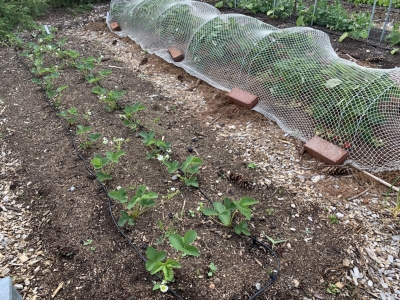
Strawberries, new and old bed
I’ll keep the new bed productive for its five years with annual renovation, a brutal affair that begins with, right after berries have been harvested, lopping off and raking up all the leaves, etc., etc. No need to dwell on this now, while enjoying berries from the old bed.
A Strawberry Better than a Strawberry
Conventional garden strawberries (Fragaria X ananassa) aren’t the only strawberries on the block. I’ve written previously about another kind of strawberry, alpine strawberry (Fragaria vesca), which is a totally different species than garden strawberries. Sure, they also have their downsides: they’re small, typically dime size; they’re very soft and perishable; and after two or three years, plants get old at their center so either need to be divided, or chucked, and new plants started.
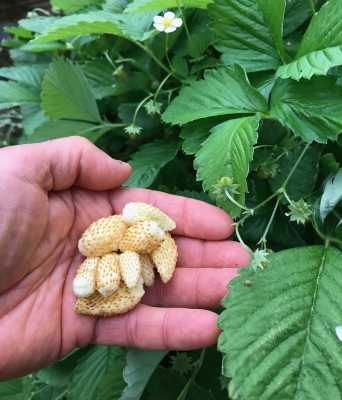
Pineapple Crush alpine strawberries
On the plus side, new plants are fairly easy to start from seed, similar to growing tomato transplants except needing more patience. And the plants bear their first season. Not only bear their first season, but bear more or less continuously all season long.
Alpine strawberries are very resistant to pest problems. And birds? No problem if you grow Pineapple Crush, the white ones. The birds ignore them. Pineapple Crush berries also have the best flavor, with more than a hint of pineapple.
I’ve been testing people’s reactions to tasting my white alpine strawberries. Without fail, within seconds of putting one in their mouth, a person’s eyes light up and they exclaim “Wow.”
Trying for the Best of Both Worlds
Okay, alpine strawberries are small. You’re not going to fill your freezer with these strawberries. Hmm, how about combining the best of garden strawberries and the best of alpine strawberries? It’s been done. The hybrids are called vescanas, botanically Fragaria X vescana, a combining of their parents’ botanical names.
As a fan of alpine strawberries, how could I resist searching for these hybrids? I found some and, last spring, planted them, the varieties Annelie, Rebecka, Sara, Florika, and, not sounding very appetizing in name, S-228. The alpine genes express themselves in disease resistance and bearing fruit more or less continuously through summer and into fall. Garden strawberry struts its genes in the hybrids’ fruit size which, for the hybrids is much larger than the alpine strawberries but smaller than the garden strawberries.
The fruits are red but red alpine strawberries, which are more common than white alpine strawberries, might have been used in the breeding.
Most evident in coming upon my small patch of these vescanas is how fast they are spreading. There are runners all over the place! I usually frown on such a habit because keeping my strawberry bed from becoming overcrowded necessitates pinching off all runners except for those needed to put rooted plants in place to replace old plants.
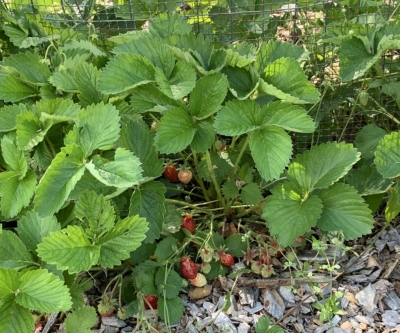
Vescana strawberries
Making lots of runners is billed as an asset for the vescanas, allowing them to be grown as so-called meadow strawberries, the meadow needing neither renovation nor mulching. I’ll let my plants wander off somewhere by themselves and see how they fare.
You may have noticed that there’s an elephant in the room; up till now there’s been no mention of flavor. I was saving that. Quoting from a journal article by the breeders of Rebecka, this variety has “fine aroma.” Perhaps in Sweden where that variety was bred. Or, quoting from the patent for Florika, “The variety is a vescana-type strawberry plant characterized by its capability of developing exceptionally rich and fine flavor of medium sized fruits.” Perhaps in Germany, where this variety was bred.
Here in New York’s Hudson Valley, I thought the fruits were good, but nothing special, and surely not as especially good as my Pineapple Crush white alpine strawberries.
Now that I think of it, Izaak Walton’s very high praise of strawberries might have been more warranted than I first noted. So-called garden strawberries are relative newcomers on the garden scene, originating as a chance hybrid in the 18th century. Prior to its arrival, the strawberries that were grown or harvested from the wild were mostly the musk strawberries (Fragaria moschata, very delicious) and alpine strawberries.
I haven’t said “wow” upon tasting any of my vescana strawberries.
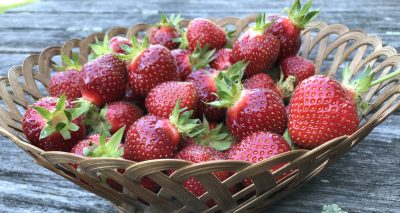
Earliglow strawberries
(For more about growing strawberries, see my book Grow Fruit Naturally).
A BRIGHT FUTURE
/15 Comments/in Fruit, Pests/by Lee ReichAs Good As It Gets
You might think that writing about good weather would tempt the fates. I’ll thumb my nose at the fates and go ahead and write that this spring is the best spring, gardenwise, ever in all the decades since I’ve been gardening. The flowers have been more vibrant with color and, it seems, also in greater profusion. The air has been particularly fragrant, especially now with the intoxicating aroma of black locust blooms following closely on the heels of autumn olive’s sweet scent.
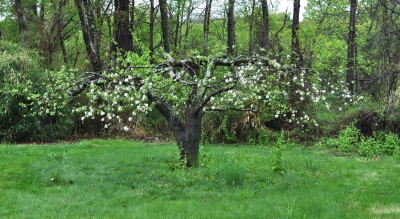
My fruit trees are most thankful for this spring’s beneficence. In all the years of growing fruit here on the farmden, never has the landscape been so brightened by snowballs of white blooms of plum and pear trees, pinkish blossoms of apples, and peaches’ pure pink blossoms.
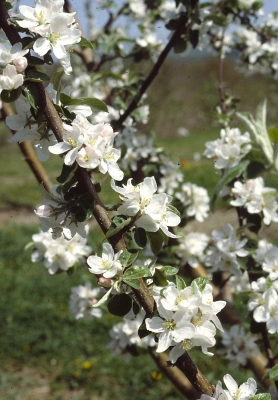

The now-fallen petals are no cause for wistfulness, because those clusters of flowers have now morphed into clusters of fruits
Why this Year?
What makes for such a glorious spring? The weather, of course, both this spring’s in addition to last winter’s and even last spring’s. Let’s first go back to last spring’s weather effects.
During spring 2020 the weather warmed going into April, coaxing flower buds on fruit trees to swell. Then, towards the end of that month and into May, a number of nights saw temperatures that nipped life from many flowers, then open, especially the 22° temperature on April 23rd and then subfreezing temperatures on May 9th, 13th, and 14th. (All this information handily recorded and passed onto my computer via Sensorpush sensors I have at two locations outdoors and one location in the greenhouse.)
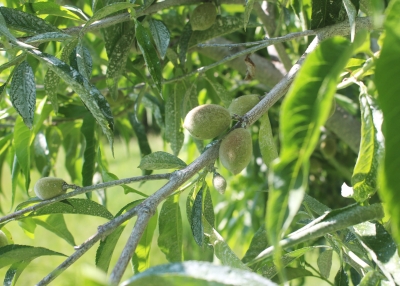
Prelude to the present season began with a relatively mild winter, for which peach flower buds, which suffer damage at around minus 15°, were especially appreciative. And this spring has seen more or less gradually warming temperatures with — and this is most important — no late, damaging frosts. Buds for a current spring’s blossoms develop the summer of the previous year. Seeds in developing fruits produce a hormone that suppresses flower bud formation, so a heavy crop one year means a lighter crop the following year, and vice versa, all other things being equal. Last year’s late frosts knocked out much of the potential fruit crop so this year the trees did what they do, compensating for last year’s loss with more blooms.
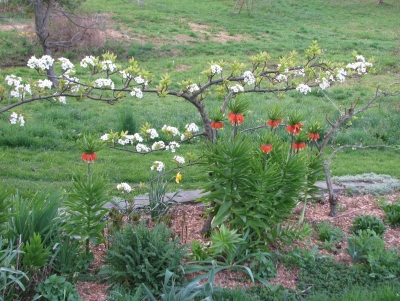
Fruit trees can afford to lose a certain number of flowers to cold each year. For instance, each flower bud of an apple tree unfolds to five flowers, and only 5 percent of those flowers need to set fruit for a full crop of apples. Furthermore, a temperature below 32° doesn’t always cause damage; just how much damage ensues depends on the the growth stage of flower buds and how cold it gets. Using apples, again, as an example, when their buds have expanded just enough to hint at the five flowers within (the “tight cluster” stage), 27° will kill 10 percent of them, 21° will kill 90 percent of them. More details for apples and other fruits can be found here.
Another variable is that temperatures can vary a little at various points within a tree, which can be important at these critical temperatures.
Not Yet Home Free
This auspicious spring is not a call for me to just sit back and wait for the delicious bounty to hang on the branches awaiting my picking. My work is cut out for me.
One job, to begin soon, will be thinning the fruit, that is, removing lots of them. In addition to upping the chances for a good return bloom and harvest next year (remember the seeds and the hormones), fruit thinning lets the trees channel more of their energy resources into fewer fruits. The result: Fruits that remain are larger and more flavorful. Fruit thinning also lessens the chance of limbs breaking under the the load of too many fruits, and lessens pest problems. Two apples touching each other provide good cover for the larvae of codling moths to burrow into the fruits to become the classic “worm in the apple.”
 Commercially, tree fruits are thinned with chemical sprays but I’ll be thinning by hand. The plan is to reduce the number of fruits to one per bud, leaving the largest and most pest-free, and allowing remaining fruits to sit no closer than about a half a foot apart along branches. Larger kinds of fruits are the ones that need thinning, which is nice because it would be very tedious to thin small fruits, such as cherries. Winter pruning removes some branches with fruit buds, so also contributes to reducing the load, as does trees’ natural shedding of some excess fruits.
Commercially, tree fruits are thinned with chemical sprays but I’ll be thinning by hand. The plan is to reduce the number of fruits to one per bud, leaving the largest and most pest-free, and allowing remaining fruits to sit no closer than about a half a foot apart along branches. Larger kinds of fruits are the ones that need thinning, which is nice because it would be very tedious to thin small fruits, such as cherries. Winter pruning removes some branches with fruit buds, so also contributes to reducing the load, as does trees’ natural shedding of some excess fruits.
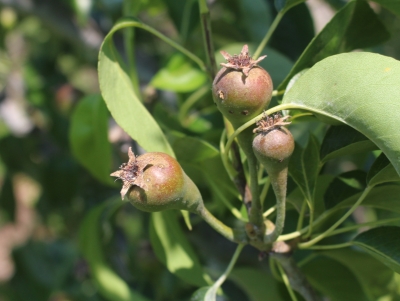
Another job, which began a few weeks ago, is keeping an eye out for and protecting fruits from insects and diseases — particularly problematic on a less than perfect site such as here on the farmden. All of the common tree fruits, except for pear, are very prone to these problems throughout much of eastern North America.
On a backyard scale, the problems are few but serious, in some cases serious enough to eliminate almost the whole crop or render it inedible. The major culprits are plum curculio, codling moth, apple maggot, oriental fruit moth, brown rot, apple scab, fire blight, and cedar apple rust. Not to mention deer and squirrels.
My tack is to take a multi-pronged approach, with some spraying (mostly organic), nurturing the soil (lots of mulch and compost) and the plants (pruning and fruit thinning), fostering beneficial insects with plantings that encourage their presence and with careful choice and limited amount of sprays, trapping pests (hanging fake apples, Red Delicious, with sticky Tanglefoot in trees), and possibly bagging individual fruits. See Grow Fruit Naturally for more about these approaches.
Even if there is “many a slip ‘twixt the cup and the lip,” every fruit grower has to be an optimist.
Plant Sale Reminder
This is the last week of my annual plant sale. For more information, go to https://leereich.com/2021/05/last-week-of-2021-plant-sale.html
And, A Free Webinar, “Weedless Gardening”
For more information, go to www.leereich.com/workshops.

